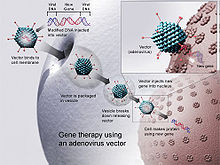
Back منشطات جينية Arabic Genetický doping Czech Gendoping Danish Gendoping German Gendopado Esperanto Dopaje genético Spanish Geenidoping Estonian Geenidoping Finnish Dopage génétique French Doping genetico Italian
| Part of a series on |
| Doping in sport |
|---|
  |

Gene doping is the hypothetical non-therapeutic use of gene therapy by athletes in order to improve their performance in those sporting events which prohibit such applications of genetic modification technology,[1][2] and for reasons other than the treatment of disease. As of April 2015[update], there is no evidence that gene doping has been used for athletic performance-enhancement in any sporting events.[1] Gene doping would involve the use of gene transfer to increase or decrease gene expression and protein biosynthesis of a specific human protein; this could be done by directly injecting the gene carrier into the person, or by taking cells from the person, transfecting the cells, and administering the cells back to the person.[1]
The historical development of interest in gene doping by athletes and concern about the risks of gene doping and how to detect it moved in parallel with the development of the field of gene therapy, especially with the publication in 1998 of work on a transgenic mouse overexpressing insulin-like growth factor 1 that was much stronger than normal mice, even in old age, preclinical studies published in 2002 of a way to deliver erythropoietin (EPO) via gene therapy, and publication in 2004 of the creation of a "marathon mouse" with much greater endurance than normal mice, created by delivering the gene expressing PPAR gamma to the mice. The scientists generating these publications were all contacted directly by athletes and coaches seeking access to the technology. The public became aware of that activity in 2006 when such efforts were part of the evidence presented in the trial of a German coach.
Scientists themselves, as well as bodies including the World Anti-Doping Agency (WADA), the International Olympic Committee, and the American Association for the Advancement of Science, started discussing the risk of gene doping in 2001, and by 2003 WADA had added gene doping to the list of banned doping practices, and shortly thereafter began funding research on methods to detect gene doping.
Genetic enhancement includes manipulation of genes or gene transfer by healthy athletes for the purpose of physically improving their performance. Genetic enhancement includes gene doping and has potential for abuse among athletes, all while opening the door to political and ethical controversy.[3]
- ^ a b c Momaya A, Fawal M, Estes R (April 2015). "Performance-enhancing substances in sports: a review of the literature". Sports Med. 45 (4): 517–531. doi:10.1007/s40279-015-0308-9. PMID 25663250. S2CID 45124293.
- ^ World Anti-Doping Agency The World Anti-Doping Code: The 2008 Prohibited List of International Standards pages 7-8
- ^ Wells DJ. 2008. "Gene doping: the hype and the reality". Br. J. Pharmacol. [Internet] 154:623–31.